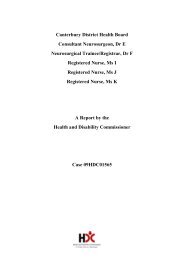Gisborne Hospital Report - Health and Disability Commissioner
Gisborne Hospital Report - Health and Disability Commissioner
Gisborne Hospital Report - Health and Disability Commissioner
You also want an ePaper? Increase the reach of your titles
YUMPU automatically turns print PDFs into web optimized ePapers that Google loves.
<strong>Gisborne</strong> <strong>Hospital</strong> 1999 – 2000<br />
Operating Theatre Protocols<br />
NZNO submission<br />
14.12 NZNO submitted that:<br />
“A nurse is able to give analgesia from a verbal order, <strong>and</strong> had she<br />
received such an order from Dr Lucas she would have acted upon it. Dr<br />
Lucas claims he gave a verbal order to the nurse but as he refused to<br />
either go to recovery or leave the operating theatre it is difficult to see<br />
how he did that.”<br />
Appropriate st<strong>and</strong>ards<br />
14.13 The Australian <strong>and</strong> New Zeal<strong>and</strong> College of Anaesthetists’ policy is set out<br />
in Review PS10 (1999):<br />
“The H<strong>and</strong>over of Responsibility During an Anaesthetic<br />
1. Introduction<br />
During an anaesthetic, the major responsibility of the anaesthetist is to<br />
provide care for the patient. This requires the continuous presence of an<br />
anaesthetist. In certain circumstances, it is necessary for the anaesthetist<br />
to h<strong>and</strong> over that responsibility to a colleague. Such h<strong>and</strong>overs will not<br />
compromise patient safety provided that appropriate procedures are<br />
followed. In prolonged anaesthetics, h<strong>and</strong>over may be advantageous to<br />
the patient by preventing undue fatigue of the anaesthetist.<br />
2. Protocol for transfer of responsibility<br />
The following matters must be considered by both the primary <strong>and</strong> the<br />
relieving anaesthetists:<br />
2.1 The primary anaesthetist must be satisfied as to the competence of<br />
the relieving anaesthetist to assume management of the case.<br />
2.2 The relieving anaesthetist must be willing to accept responsibility<br />
for the case.<br />
2.3 Review of the patient’s health status having regard to past history<br />
<strong>and</strong> the present condition.<br />
2.4 A description of the anaesthetic including drugs, intravascular<br />
lines, airway security, fluid management, untoward events <strong>and</strong> any<br />
foreseeable problems.<br />
2.5 Observations of the patient according to College Policy Document.<br />
2.6 A check to ensure correct functioning of the anaesthetic machine,<br />
monitoring devices in use <strong>and</strong> any other equipment which is<br />
interfaced with the patient.<br />
129
















